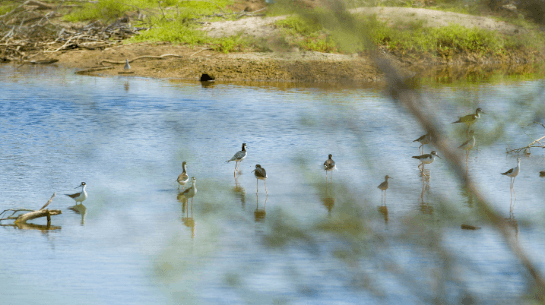
Migratory birds and their environment
Migration is the directional movement of individuals of certain species that moves from the breeding area to feeding and resting areas at a certain period of the year. In other period, the animals return to their breeding area, repeating this cycle every year. This phenomenon among birds is caused by the food supply seasonally available. Birds that make this constant move are known as migratory.
There are seven migratory routes in the world, known as “Flyways" and Brazil is the only country in the world having two of them.
The migration process has fascinated researchers for centuries. The beauty of animal group movements, together with the achievement of overcoming impressive physical barriers, such as deserts and mountains, has made migration the subject of many studies, especially in relation to small migratory birds.
FLYWAYS BRASIL
“Flyways Brasil” project is a partnership of SAVE Brasil with Neoenergia Institute and its purpose is the monitoring of shorebirds population in Potiguar basin, Rio Grande do Norte, as well as engaging social actors and the local community in the preservation of these birds and promoting the safety of important habitats for them
Although shorebirds can be found in several biomes, they are generally associated with wetlands, essentially coastal areas such as estuaries, mangroves and lagoons. Many of these species are known for their vast migrations, in some cases going from the Arctic to the South region of the Southern continents.
They eat small invertebrates that live in the "limus" (Latin mud). Most of these species, which are distributed in 13 families of the Charadriform order, are migratory. This group includes Knots (Maçaricos), Semipalmated Plovers (Batuíras), Lapwings (Quero Queros), Haematopus palliatus (Piru Pirus), Stilt Sandpipers (Pernilongos) and South American Snipes (Narcejas). Of the 47 species found in Brazil, 13 are resident, four are Southern Cone migrants and 30 come from the Northern Hemisphere.
CONTINENTAL DISTANCES
Migration is a part of the cycle of life of many birds. It is necessary for them to continue developing the biological processes of the species, such as the exchange of feathers. Each migratory bird has its own travel route and final destination. The route varies from species to species and is directly related to the birds' eating habits. There are numerous migration routes, many still unknown by researchers, but we can classify some, as large or small routes.
Some birds cover more than 10 thousand kilometers until they reach their destination. One of them is the Peregrine Falcon that flies around 20 thousand kilometers to arrive to the extreme south of South America. In large migrations, the birds need to land in favorable areas to build up the necessary reserves and continue the long journey. The migration must generate a huge gain for the bird, because it is an energy-consuming phenomenon. For some bird species, for example, the food source is unavailable during the winter and the benefits of migration are very clear. For others, the energy return consists of the savings they would spend to maintain their metabolism in the thermal stress they were suffering. And for others, the main migration benefit is the reproduction during the summer, when the resources are abundant.
Ruby-throated Hummingbird, Archilochus Colubris, are the smallest migrant endotherms and also have an impressive performance in migration. They make a non-stop flight of 800 kilometers across the Gulf of Mexico at a speed of 40 kilometers per hour making the journey in 20 hours.
THREATENED BIRDS
COLORING BOOK
October is the month when we celebrate Children's Day and it is also the month when the World Bird Day (10/5) and World Migratory Bird Day (10/10) are celebrated as well. To celebrate these dates, Neoenergia Institute and SAVE Brasil launched the “Migratory Bird" Coloring Book, that provides, using a youth language, many curious and educational information on six species of shorebirds - birds that eat invertebrates hidden in the mud - where five of them are migratory birds.
These birds can be seen in some periods of the year, at the potiguar basin, in Rio Grande do Norte State. There are 15 pages produced in a very accessible format to children and adolescents, with the presentation of migratory shorebirds, such as the Red Knots, included in the listing of the Ministry of the Environment as one of the endangered species in Brazil, and which spends the months of September to April in the country, to then migrate to the Arctic, where it breeds.
News
2025-04-22
Neoenergia vende 50% de Itabapoana Transmissão
2025-04-15
Nova campanha da Neoenergia celebra a potência feminina no esporte e reforça apoio às atletas embaixadoras da marca
2025-03-27
Instituto Neoenergia lança chamada inédita unificada de editais para apoiar projetos sociais
2025-03-21
Neoenergia é reconhecida entre as empresas mais exemplares do mundo em sustentabilidade
2025-03-14
